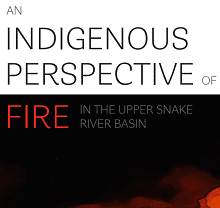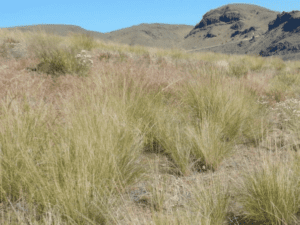Research and Publications
View booklet.
The reciprocal nature of our human interactions with our natural environment can be viewed through the lens of fire management in the West by federal, state, and private land managers. A wildfire’s impact is not affected by the presence of a geopolitical boundary, it is still inherently a natural process fueled by relatively well-understood dynamics. Yet, changing climate conditions such as extended heat waves, droughts, shifts in rainfall patterns or types of precipitation are changing how fire behaves in the West. From a Tribal member’s perspective, these climatic conditions, social development, and ecological degradation are all connected events with relatively predictable consequences. Because there is a reciprocal relationship with our environment, we are collectively accountable for the consequences of our choices in a modern context through a changing climate.
View (and/or order) the poster.
Sagebrush ecosystems, broadly distributed across western North America (see map), are imperiled due to a combination of modern and historical factors causing widespread degradation and habitat loss. Sagebrush shrubs are so common in these ecosystems that they create a “sea” across the landscape. This poster highlights wildflowers (forbs) common in sagebrush vegetation of the Great Basin.
These wildflowers support countless wildlife species, including some species only found in sagebrush ecosystems, such as the greater sage-grouse. (See “High sage-grouse value.”) Many forb species (including most featured here) are highly valued and used for food, medicine and ceremony by the many Indigenous peoples of the Great Basin. There are hundreds of forb species in sagebrush ecosystems, all with their own unique characteristics. The 31 species on this poster highlight common species potentially useful in restoration. These species also represent the variety of size, height, flowering timing and taxonomy (evolutionary relationships) found in typical sagebrush communities. Note: These species rarely, if ever, occur as closely together as shown in this poster.
View guide. (Click on the word “guide” to view it.)
A photo guide for use in classifying fire behavior fuel models from the Scott and Burgan (2005) library that are common to the sagebrush steppe of the American west. The goal of this guide is to enable the quick and easy classification of fuel models in sagebrush steppe to –
- enhance the mapping of fuel beds in an increasingly fire prone region,
- guide the evaluation of fuel and post-fire restoration treatments, and
- improve our understanding of fuel conditions during times of the year when wildfire preparedness is greatest (i.e. hot and dry).
View article.
We sampled depth-resolved layers from fire-impacted soil and combusted litter and woody materials in a series of recent pile burn scars near West Yellowstone, Montana and nearby unburned mineral soil controls to assess whether the pile burn scars exhibited microbial signatures characteristic of forest soils impacted by recent high severity wildfire. Changes in soil carbon and nitrogen chemistry and patterns of microbial alpha and beta diversity broadly aligned with those observed following wildfire, particularly the enrichment of so-called ‘pyrophilous’ taxa. Furthermore, many of the taxa enriched in burned soils likely encoded putative traits that benefit microorganisms colonizing these environments, such as the potential for fast growth or utilization of pyrogenic carbon substrates. We suggest that pile burn scars may represent a useful proxy along the experimental gradient from muffle furnace or pyrocosm studies to largescale prescribed burns in the field to advance understanding of the soil (and related layers, like ash) microbiome following high severity wildfires, particularly when coupled with experimental manipulation. Finally, we discuss existing research gaps that experimentally manipulated pile burns could be utilized to address.
View article.
Strategic development and implementation of burn boss training may increase the likelihood that burn bosses can safely and effectively implement prescribed burns. This article presents a case study for applying key adult learning methods to improve training effectiveness that can be applied to other training topics in and outside wildland fire management.
View article.
We investigated the relationship between aspen regeneration and site moisture availability potential using ecosystem type as a proxy. We hypothesized that aspen stands growing along perennial-flowing streams would support higher aspen regeneration densities than upland aspen stands. We compared stand structure, groundcover composition, and regeneration densities of nine riparian aspen stands with nine paired upland aspen stands in the Caribou-Targhee National Forest. Aspen regeneration densities were significantly higher in the riparian aspen stands (845. 3 + 318.7 stems ha-1) compared to the upland aspen stands (249.1 + 74.1 stems ha-1) for regeneration shorter than one meter (p = 0.0391). Riparian stands also exhibited significantly higher forb (p< 0.001) and graminoid (p < 0.001) cover compared to upland aspen stands, suggesting that riparian sites provided higher site moisture availability. We suggest that riparian areas may provide refugia for aspen in the future considering projections of increased incidence of acute drought.
View article.
We created range-wide phenology forecasts for two problematic invasive annual grasses: cheatgrass, and red brome . We tested a suite of 18 mechanistic phenology models using observations from monitoring experiments, volunteer science, herbarium records, timelapse camera imagery, and downscaled gridded climate data to identify the models that best predicted the dates of flowering and senescence of the two invasive grass species. We found that the timing of flowering and senescence of cheatgrass and red brome were best predicted by photothermal time models that had been adjusted for topography using gridded continuous heat-insolation load index values. Phenology forecasts based on these models can help managers make decisions about when to schedule management actions such as grazing to reduce undesirable invasive grasses and promote forage production, quality, and biodiversity in grasslands; to predict the timing of greatest fire risk after annual grasses dry out; and to select remote sensing imagery to accurately map invasive grasses across topographic and latitudinal gradients. These phenology models also have the potential to be operationalized for within-season or within-year decision support.
View article.
Distributions of both native and invasive species are expected to shift under future climate. Species distribution models (SDMs) are often used to explore future habitats, but sources of uncertainty including novel climate conditions may reduce the reliability of future projections. We explore the potential spread of the invasive annual grass ventenata (Ventenata dubia) in the western United States under both current and future climate scenarios using boosted regression tree models and 30 global climate models (GCMs). We quantify novel climate conditions, prediction variability arising from both the SDMs and GCMs, and the agreement among GCMs. Results demonstrate that currently suitable habitat is concentrated inside the invaded range of the northwest, but substantial habitat exists outside the invaded range in the Southern Rockies and southwestern US mountains. Future suitability projections vary greatly among GCMs, but GCMs commonly projected decreased suitability in the invaded range and increased suitability along higher elevations of interior mountainous areas.
View article.
Cloud-to-ground lightning with minimal rainfall (“dry” lightning) is a major wildfire ignition source in the western United States (WUS). Although dry lightning is commonly defined as occurring with <2.5 mm of daily-accumulated precipitation, a rigorous quantification of precipitation amounts concurrent with lightning-ignited wildfires (LIWs) is lacking. We combine wildfire, lightning and precipitation data sets to quantify these ignition precipitation amounts across ecoprovinces of the WUS. The median precipitation for all LIWs is 2.8 mm but varies with vegetation and fire characteristics. “Holdover” fires not detected until 2–5 days following ignition occur with significantly higher precipitation (5.1 mm) compared to fires detected promptly after ignition (2.5 mm), and with cooler and wetter environmental conditions. Further, there is substantial variation in precipitation associated with promptly-detected (1.7–4.6 mm) and holdover (3.0–7.7 mm) fires across ecoprovinces. Consequently, the widely-used 2.5 mm threshold does not fully capture lightning ignition risk and incorporating ecoprovince-specific precipitation amounts would better inform WUS wildfire prediction and management.





